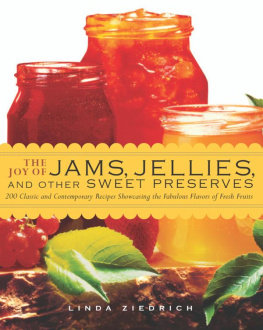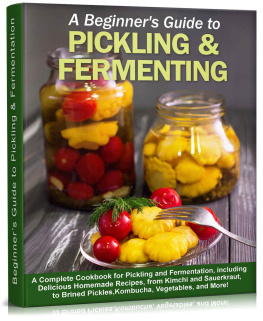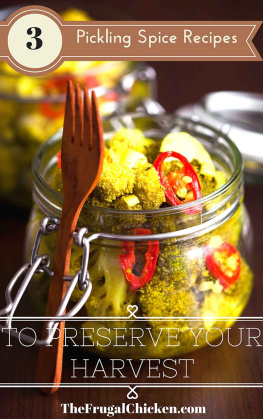The Joy of
Pickling
THIRD REVISED EDITION
300 Flavor-Packed Recipes for All Kinds of Produce from Garden or Market
Linda Ziedrich
Foreword by Christopher Kimball


2016 Quarto Publishing Group USA Inc.
Text 2016 Linda Ziedrich
First edition published in 1998.
Second edition published in 2009.
Published in the United States of America in 2016 by
Harvard Common Press, an imprint of
Quarto Publishing Group USA Inc.
100 Cummings Center
Suite 406-L
Beverly, Massachusetts 01915-6101
Telephone: (978) 282-9590
Fax: (978) 283-2742
QuartoKnows.com
Visit our blogs at QuartoKnows.com
All rights reserved. No part of this book may be reproduced or utilized, in any form or by any means, electronic or mechanical, without prior permission in writing from the publisher. All images in this book have been reproduced with the knowledge and prior consent of the artists concerned, and no responsibility is accepted by producer, publisher, or printer for any infringement of copyright or otherwise, arising from the contents of this publication. Every effort has been made to trace the copyright holders and ensure that credits accurately comply with information supplied. We apologize for any inaccuracies that may have occurred and will resolve inaccurate or missing information in a subsequent reprinting of the book.
Digital edition: 9781-5-5832-870-9
Softcover edition: 9781-5-5832-860-0
Library of Congress Cataloging-in-Publication Data Available
Design and Page Layout: Ralph Fowler / rlf design
Cover Image: Glenn Scott Photograph
Illustration: Rodica Prato
Contents
Guide
My chutneys and kasaundies are, after all, connected to my nocturnal scribblingsby day amongst the pickle-vats, by night within these sheets, I spend my time at the great work of preserving. Memory, as well as fruit, is being saved from the corruption of the clocks.
Salman Rushdie, Midnights Children
Foreword
I grew up on a small farm in the Green Mountains of Vermont and I remember stories of the old days when the pace of life was quite different. Everything moved by horsepower, up and down the main road. Mail was delivered by horse and buggy, and, in a tradition that continued through the 1960s, the mailman on his morning rounds was known to help out with chores, like checking the wood stove at Harry Skidmores place when nobody was home.
When you needed to find a good spot to dig a well you hired a dowser. He would cut off a forked branch from an apple tree and hold it in front of him with arms crossed. The branch would pull downwards when water was near. Frasier Mears, who did the dowsing in our town, talked to his rod as if it were alive. Tell me, Mr. Stick, he would say, how far is it? Or Tell me, Mr. Stick, is it deep?
Some of our neighbors still remember when they saw their first car. Russell Baines didnt see one until he was eleven years old, but they werent good for much in those days. If you could drive ten miles and back without a flat, he told me, you bragged about it. One farmer figured he could solve the problem by putting rope in the tires so they would have something to run on. It worked fine until the rope heated up from friction and burst into flames. A horse, by contrast, has always been a more reliable means to get around. As Junior Bentley once said to me, concerning the difference between tractors and horses, On a cold morning, I always know that a horse is going to start up.
In the 1950s, folks in our town were still picking dandelion, milkweed, and mustard, still turning milk into cheese and butter. For meat, there was wild game and a hog or steer raised out backbehind the chained beagle, who in the winter would be let loose just a half dozen times or so for hunting rabbits.
Since the growing season was so short, most everything was preserved. Beef tongue was pickled, fruits were made into jams and fruit butters, and corn was turned into succotash. Root vegetables were packed into crates and carried down to the cellar.
It is therefore with a great deal of admiration and enthusiasm that I first read The Joy of Pickling. By working a special magic on an abundance of garden produce, Linda Ziedrich has transformed what might have become a lost art into something both necessary and delightful. Who wouldnt head for the kitchen to make Spicy Crock Pickles, or Indian-Style Pickled Cauliflower, or Limed Green Tomato Pickle? This is a book not just about saving money or rescuing a surfeit of cucumbers and cherry tomatoes from the pitfalls of superabundance. It is about applying simple methods to simple ingredients to produce tastes and textures that are both unexpected and extraordinary. Even in an age marked by home kitchens used for reheating instead of cooking, pickling is a thoroughly modern notion, one that requires little time and expense and pays great dividends.
It is my great hope that as we taste our first batch of half-sours or Italian pickled raw eggplant, we will stand by the stove and recall the May planting; the young sprouts shooting up from the cool soil; the long, slow maturing of the fruit through the hot days of July and the cool nights of August; and, finally, the act of pickling itselfgreat crocks filled with their sharp, briny liquid, just-picked vegetables submerged and ready to change into something crisp and wonderful.
For too many of us, our crop of memories is hardly worth preserving, like a small, scarred fruit without a gardener and cook to see it through from simple beginnings to ripe fruition. I often think that in cooking one can find all things: recollection, experience, hope, nourishment, and a simple faith in providence. Pickling serves up crisp memories, summer fruits and vegetables alive with the scent and taste of lifes possibilities.
Christopher Kimball, host of PBSs Americas Test Kitchen, founder of Cooks Illustrated and Cooks Country magazines, and author of The Cooks Bible, The Yellow Farmhouse Cookbook, and The Dessert Bible
Preface
Never a big pickle eater myself, I became inspired to write this book after my son Ben, then about seven years old, developed a taste for cucumber pickles. I hesitated to buy the ones in the grocery store, which were dyed and preserved with scary-sounding chemicals as well as the usual salt and vinegar. Id occasionally made pickles from farm-grown cucumbers, but truly fresh ones were very hard to find. Although I kept a large vegetable garden, I had never grown my own cucumbers. So I planted some. Soon I was pickling homegrown cukes, and our abundant pears, plums, peppers, and beans as well.
I didnt get really interested in pickles, though, until I started making the fermented kind. My husband and I are both endlessly intrigued by the way invisible little creatures transform raw plant materials into wonderfully nourishing and tasty foods; this must be part of the reason he makes beer and wine and I make about ten pounds of bread every week. We relished the complex flavors of my home-brined pickles, each batch a little different from the one before. I was amazed, too, to discover that cucumbers arent the only foods suitable for brine-pickling; many other vegetables, and even some fruits, are enhanced by this magical metamorphosis.









